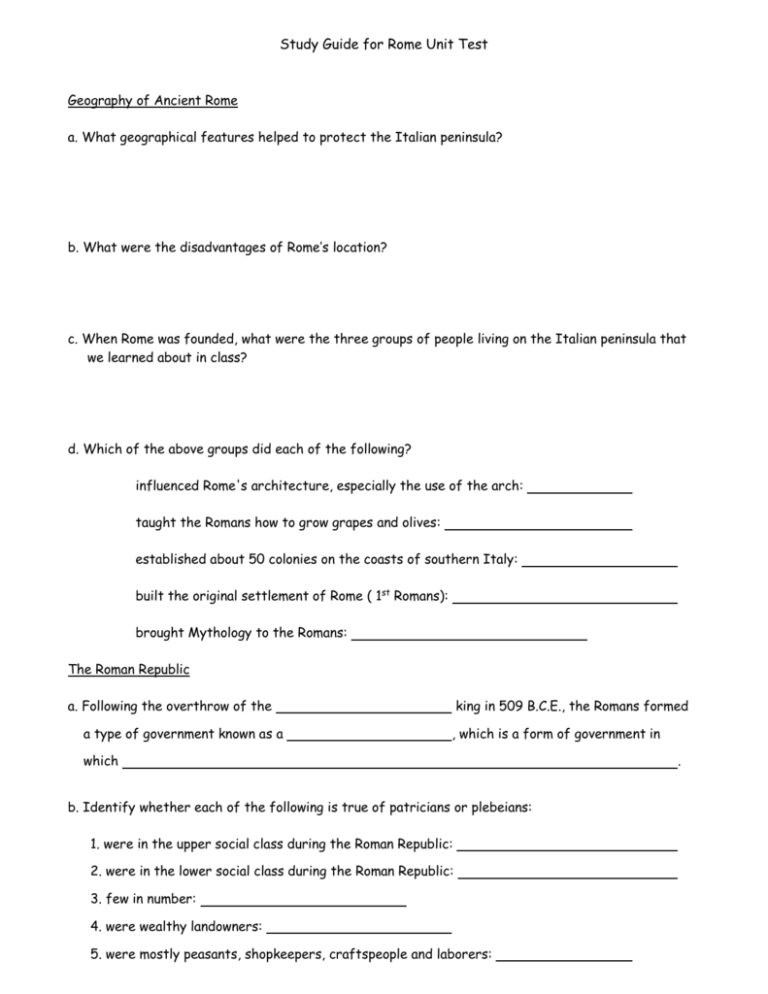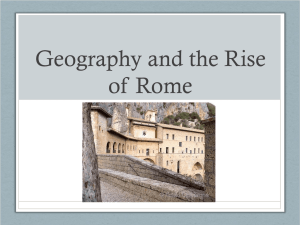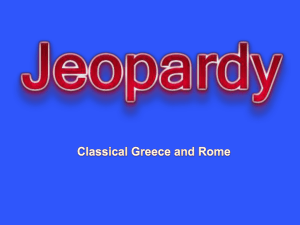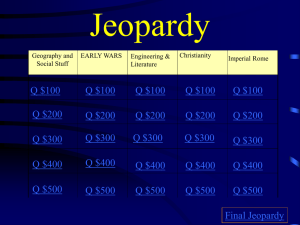Study Guide for Rome Unit Test Geography of Ancient Rome a
advertisement

Study Guide for Rome Unit Test Geography of Ancient Rome a. What geographical features helped to protect the Italian peninsula? b. What were the disadvantages of Rome’s location? c. When Rome was founded, what were the three groups of people living on the Italian peninsula that we learned about in class? d. Which of the above groups did each of the following? influenced Rome's architecture, especially the use of the arch: taught the Romans how to grow grapes and olives: established about 50 colonies on the coasts of southern Italy: built the original settlement of Rome ( 1st Romans): brought Mythology to the Romans: The Roman Republic a. Following the overthrow of the a type of government known as a king in 509 B.C.E., the Romans formed , which is a form of government in which b. Identify whether each of the following is true of patricians or plebeians: 1. were in the upper social class during the Roman Republic: 2. were in the lower social class during the Roman Republic: 3. few in number: 4. were wealthy landowners: 5. were mostly peasants, shopkeepers, craftspeople and laborers: . 6. held the important government and religious positions: 7. their rebellion was known as the Conflict of the Orders: 8. had little say in government in the early years of the Roman Republic: c. The government of the early Roman Republic included a Senate, consuls, dictator and assemblies. Describe each. Senate: Consuls: Dictator: Assemblies: d. What major step did the plebeians take in 494 B.C.E.? e. This act by the plebeians in 494 B.C.E. led, over time, to a number of reforms, which included: f. Prior to the creation of the Twelve Tables, the laws created by the patricians were not in writing. Why was this a problem for the plebeians? g. During the early days of the Roman Republic, who were considered to be citizens? h. What were some of the rights and responsibilities of Roman citizenship? The Punic Wars a. The Punic Wars were fought between b. The Punic Wars consisted of and . separate wars. (Provide a number.) c. Provide the following information about the First Punic War: 1. Who started it, who won and what did the winner get? d. Who started the Second Punic War? Why? Describe the main events of the Second Punic War and results of the Second Punic War. e. Who started the Third Punic War? Why? What was the result of the Third Punic War? Decline of the Roman Republic a. What events primarily contributed to the decline of the Roman Republic? b. Who were Tiberius and Gaius Gracchus and what did they try to do? c. Describe the rise and fall of Julius Caesar. Your description should include the following terms/names: civil war, First Triumvirate, Pompey, Crassus, Caesar, dictator for life and Senate. d. Why was Caesar so popular? What did he do that made him popular with the people (especially the poor)? e. Describe the process through which Octavian became the first Emperor of Rome (be sure that your answer includes an explanation of the Second Triumvirate). f. When Octavian became emperor, he took the new name/title of _______________________ __________________________________. Pax Romana a. The 200 year period of peace and prosperity that began with the reign of Augustus Caesar is known as the ___________________________________. b. True or false: The Pax Romana was a time of economic prosperity. c. Name TWO reasons that trade became easier during the Pax Romana: d. Describe the civil service system established during the Pax Romana: e. The Romans also established the idea of rule of law, which is the idea that . f. During the Pax Romana, family was very important. Explain the role of each of the following: paterfamilias: women: children: g. Was slavery common during the Pax Romana? h. What Roman architectural achievements (including famous buildings) did we learn about in class? i. Identify what each of the following were used for: 1. Pantheon: 2. Colosseum: 3. Forum: j. Be able to identify images of the Pantheon, Colosseum and Forum. k. What Roman technological achievements did we learn about in class? l. What is shown in the image to the right AND what was its purpose? m. _________________ was a famous Roman astronomer, geographer and mathematician who lived in Alexandria, Egypt. n. The language of the Roman Empire was _______________. The languages that developed out of Latin (such as French, Spanish and Italian) are known as __________________________ _____________________________________. o. One of the most famous writers of the Roman Empire was _______________, who wrote an epic poem titled _______________________. p. Three types of art that were common during the Roman Empire that we learned about in class were ___________________, ____________________ and _______________________. q. In the area of law, the Romans developed the idea that all people are considered _______________________ until proven _______________. This idea first appeared in the________________________________________________. Roman Mythology and Religion a. Roman mythology was based on _____________ religion. Like Greek mythology, Roman mythology honored and worshipped many gods and goddesses. In other words, this religion was ______________________________. b. Identify each of the following Roman gods/goddesses: 1. father of the gods; Greek counterpart was Zeus: 2. wife of Jupiter; looked after women; Greek counterpart was Hera: 3. god of sun and light; same name in Greek mythology: 4. goddess of the hunt, moon and birth; Greek counterpart was Artemis: 5. goddess of arts and wisdom; Greek counterpart was Athena: 6. goddess of love; Greek counterpart was Aphrodite: Decline of the Empire a. Identify contributing factors that led to the decline of the Roman Empire in each of the following categories: 1. size of the Empire at its greatest extent: 2. economy: 3. military: 4. morality: 5. political problems: 6. invasion:









